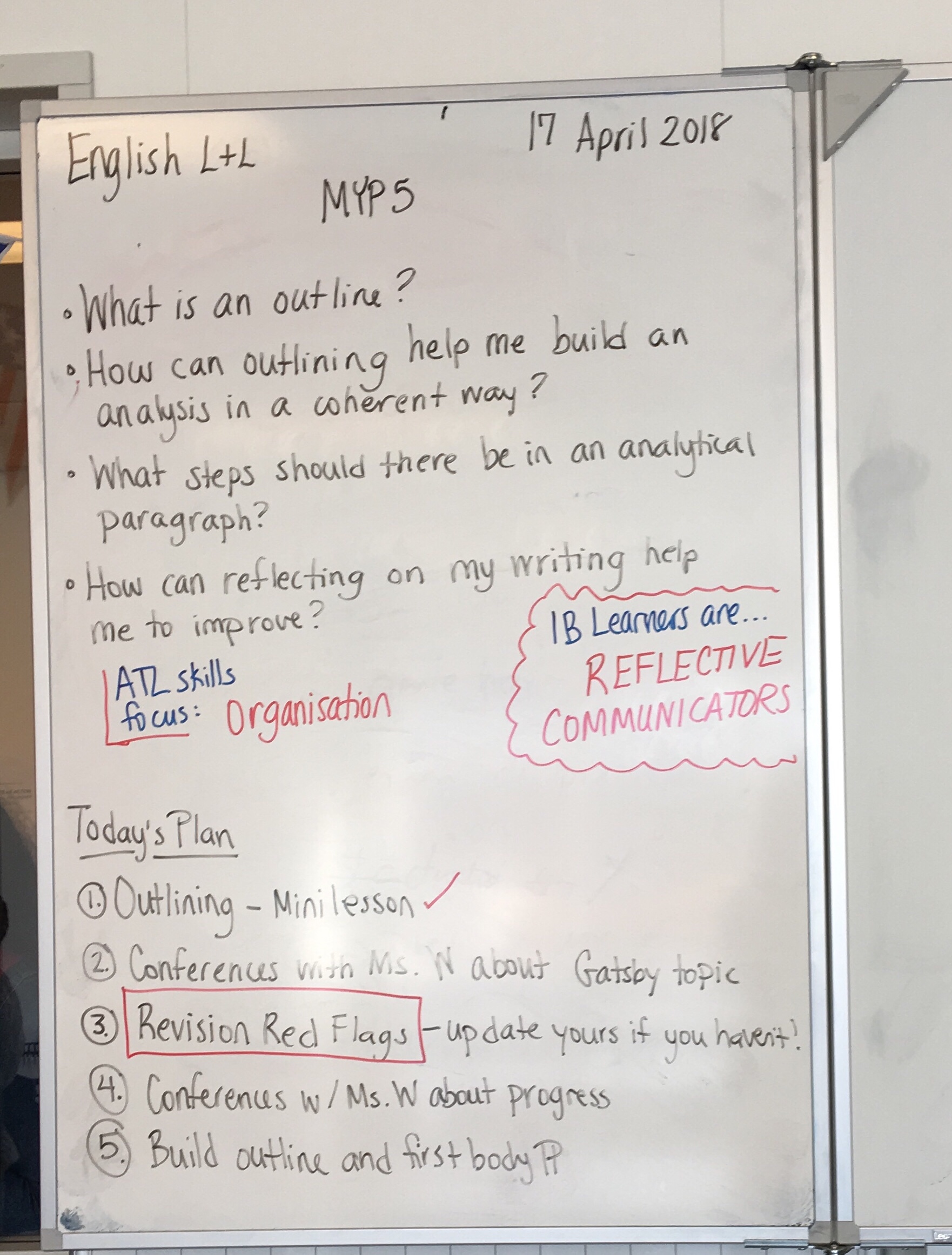April 17th, 2018 | Filed under: teaching
I’ve realized over these last few years how crucial routine is in my classroom. I’ve achieved this by trying to get scheduled in the same room regularly, but that’s not always possible. However, every room has a board and I use it in the same way for every lesson – as an agenda for inquiry.

Students walk in and see the board and they know what the plan is…for the most part. This can calm nervousness about what to expect and it often answers questions that come up at the beginning of the lesson. “Miss, are we going to…” or “Miss, can we have time to…” I still get those questions, but students often can answer those themselves by checking out the board on the way in. This gives me time to take attendance and answer questions that can’t be answered by the board.
Finally, the board format gives us a chance to reflect and close out the lesson. What didn’t get done? Why? What do we need to work on?
It’s not SWBAT, but in some ways it serves the same purpose with an MYP inquiry twist.
Tags: inquiry, MYP, routine No Comments »
September 24th, 2012 | Filed under: teaching
Last year I started my first international school teaching job here in The Netherlands at a school implementing the Middle Years Programme. I was so excited! Concept based curriculum, theme-based units, opportunities to incorporate all sorts of texts and assessments, no mandates or state standards to worry about! Just a framework within which I was expected to bring students to a general set of objectives in the subjects I teach, which are English and technology.
Now, there are few “MYP textbooks” out there. And if you talk to most teachers working in the program, many just use their own resources, gather materials from a selection of books, use the Internet, etc. It’s great to be able to do that. Last year I decided not to order any textbooks and instead focus on getting short stories online or from anthologies, use our sister school’s library, etc.

cc licensed ( BY ) flickr photo shared by BiblioArchives / LibraryArchives
In short, it was exhausting. I’ve been trying to think about why this was so hard for me and I’ve come to a few conclusions:
-
There is no curriculum – I’m writing it. This freedom is both exhilarating and overwhelming at the same time. Everything was an option, which sometimes froze me in my tracks.
-
I haven’t been teaching that long. Veteran teachers have that expert knowledge that comes from years of experience – they know what texts are great for which age group and can work from those experiences. I have a few of those I’m coming from, but not nearly enough to make planning a breeze. It’s still a big learning curve for me.
-
Scouring the Internet for resources isn’t as easy and relaxing as it seems. In addition to planning MYP units (very labor intensive for those new to it), crafting assessments and task-specific rubrics, marking and starting up the school, searching for resources online late at night to fit my unit question was painful. It wasn’t enjoyable.
So this year I made a decision to purchase some textbooks. A selection of literature textbooks to add to the resources I purchased last year (short story collections, a few novels) and the resources we have at our neighboring school library. For a second I cringed as I made the order – am I failing in a way? Am I taking the easy way out?
I think most of the negativity towards textbooks comes from the fact that they try to sum up an entire course in one book and we know, as teachers of our subject, that’s just not possible. Who do they think they are? Really?

cc licensed ( BY ) flickr photo shared by textbookrebellion
And don’t get me started on the corporate nature of textbook companies, the up-selling, the price of these things, etc. There are a lot of reasons to talk trash about textbooks. But, just like timed writing and test preparation, I’m finding they have their place.
So, I’m sitting here on a rare Friday off, sipping some tea and flipping through a collection of myths and folktales in one of the textbooks. During my student teaching, myths and folktales was one of the first units I taught and I loved it. My MYP 1 students (6th graders) are studying oral traditions and storytelling before they compose their own myths to read to our primary students. I’m enjoying what I’m finding in the textbook. There are a few activity ideas I hadn’t thought of and some great guiding questions I could use in discussion with my students. That doesn’t mean I’m going to assign the question list for homework or anything like that, but I’m picking and choosing. And not feeling dirty about it. These textbooks are for me – to the students, nothing much has changed.
As new teachers we’re confronted with a lot of issues and controversies about which we’re supposed to make an opinion, right there and then. Just by scrolling through my Twitter feed I’m confronted with hot button issues, words I’m supposed to stop using, new euphemisms to embrace. I had a lot of strong opinions about what is supposed to happen in a classroom and how a teacher is supposed to do things. That was before I actually worked in a classroom. I’m realizing, somewhat begrudgingly, that there’s a lot of grey area in what we do.
So here I am, flipping through a textbook, and loving it. It’s not the answer. It’s not replacing my planning. It’s not my easy way out. But it is a part of what I do and I’m not going to feel bad about it. In fact, I kind of regret not ordering them sooner.
Tags: curriculum, middle years programme, MYP, realizations, resources, textbooks 5 Comments »
August 2nd, 2011 | Filed under: teaching
It’s a strange thing being a part of a digital network of teachers from all over the world, especially when you’re still a new teacher, feeling your way through this complex profession (when do you stop feeling new?). Even weirder when you’ve moved to a new country and are helping to open a school from the ground up. A terrifying, exciting, once-in-a-lifetime experience. Did I mention terrifying?
As the time ticks down to the end of August when I will meet my students for the first time – students that will likely be from all over the world, with experiences my younger self could only dream of having, with passport stamps to lands I’ve only seen in movies – sweat is beginning to bead upon my brow. My breathing has increased in pace and seems unlikely to slow until I get into a groove this fall and find some confidence and systems and routines. Sleep is unfulfilling and interrupted with bursts of 3:30 a.m. panic or inspiration or both.
See, I haven’t taught for the last year. I moved to The Netherlands in the summer of 2010 and spent months securing residency and trying to settle into my new home. I have had my head in the education world thanks to some other work and planning this new school, but as for teaching, I’ve not been in a room with students since June 2010. And really, I hadn’t spent too much time working with students before that. Still a “new” teacher, remember?
I am a new teacher. In a new school. In a new country. Doing so many new things, I feel like I’m learning with every turn. Nothing feels like something I’ve done before. This is a powerful and exhausting experience and I constantly find myself asking “is this right?” I try to see my newness as a positive and not as a disadvantage, but there are those days where you can’t help but feel like you will never measure up to the pros.
Thankfully I have that digital network of teachers behind me. It can feel, at times, like a sounding board in the form of a well-worn safety blanket – something to run to when you just don’t know where else to go. This metaphor could be perceived any number of ways – is it a way to feel “connected” in a profession prone to loneliness? Or a false sense of security in a job where, in the end, you really do it on your own every day?
But a strange thing has happened. As I feel the pressure of not disappointing my colleagues, parents, my new students, myself…I feel an even bigger pressure not to disappoint this network. See, when you surround yourself with people you consider experts – people you admire and learn from every day, sharing wowing ideas and experiences in education – you also have an even bigger cadre of people you can disappoint. This pushes me to try harder and do my best, but I know there will be mistakes. There will be days when I think “man, should I even BE a teacher?” I’m wondering if I’ll be confident enough to share those moments with these same teachers, or if I will bury them away in my notebook and keep the shame to myself. I find myself wondering if the “mistakes” shared by the educators I connect with online are akin to the “weaknesses” job applicants share in interviews – perceived downsides that really just beef up your strengths in the end. Do we really share the teaching skeletons in our closets? The moments we were so happy no one was observing that day? The strategies we used and think back on with the sort of stomach turning that only an embarrassing, high school moment can induce? And if we don’t share them, acknowledge them, and think about them, do we really learn from them?
I will be teaching Language A & B English and Technology in all years of the MYP* in addition to some other hats this year as our new school opens later this month. A new school necessitates many hats being worn by only a few teachers. I bounce between moments of feeling brave and proud of myself for tackling such a project, but as the days tick closer those wins are punctuated with “are you crazy? What makes you think you can do this? Leave this stuff up to the pros – you’re not there yet.'” My consolation is knowing that my colleagues are in this with me. We are heading into unfamiliar seas and it is scary, but we are together.
I know the path toward becoming a great teacher means walking that path as a teacher. I know at some point you have to leave behind consuming and reading and learning from your network – the theory – to do the thing you believe you were meant to do – teach. After a year of floating around, I may not feel completely ready to do that, but I am hoping when I do I can turn back to that same group of teachers and say “you were right. It wasn’t so bad. In fact, it was amazing. And damn, it feels good to be here again.”
*This equates to 6th through 10th grade in the U.S. As a small school, we will have some grouping of grades, which is yet another new and exciting experience for me.
Tags: ISB, MYP, networks, new teacher, personal learning network, PLN 4 Comments »
January 28th, 2011 | Filed under: Opinion, teaching
Not in The Netherlands it doesn’t. I’ve not had a great deal of exposure to Dutch work environments other than the few times I’ve visited the immigration office and the time I’ve spent with the curriculum team developing a new international school. Working from home isn’t all it’s cracked up to be. But even after a few visits to real workplaces, something is startling clear: Casual apparel is okay in The Netherlands, especially in the workplace.
In America, as most Americans can attest, your work attire is taken very seriously, particularly in offices. As a newspaper reporter I only dressed up when heading to a cushy office to interview someone and the rest of the time I rocked jeans and casual dresses. In a workplace where people (used to?) smoke and keep bottles of bourbon in their desks, this is an improvement. But when I became a teacher that all changed. I needed to “dress respectably to be respected,” as one principal told the staff during a meeting. Apparently dressing respectably meant skirt and pants suits like the administrators wore each day.

Last week I had the wonderful opportunity to begin training in the MYP curriculum. It was an all-day session that challenged me and my new colleagues to move away from our previous experiences as educators and think within this new curriculum focused on authentic, project-based learning and interdisciplinary collaboration. I’m still reflecting on the experience and writing about it, which I’ll share soon, but as invigorating as the experience was it was also a chance for me to chat casually with these teachers. Usually we’re cramming a lot into our meetings and have little time for chit-chat, but we had lunch together and tea breaks and I shared a lot about myself, the true outsider on the team, and learned more about them. Photo by semuthutan.
The most glaring difference I found while hanging out in the personeelskamer (teacher’s lounge) is that seeing people “dressed up” was a rarity. Now, these educators weren’t rolling into work in sweat pants, but here are just a few examples:
– Older gentleman in jeans, flannel shirt, suspenders, sneakers.
– Younger woman in cotton dress, tights, Ugg-type boots.
– Administrator in khakis, button-down shirt (no tie), and a houndstooth jacket.
– Younger man in khakis, loafers, and an untucked polo shirt.
It may seem that I’m being overly superficial, analyzing the wardrobe choices of the teachers I encountered, but it affected me so much that I knew there had to be a reason. I realized that this casualness toward dress code was indicative of something deeper in the culture of the school and the attitude toward the teachers. They are considered professionals and treated as such. It’s as if someone said “Yes, I know you’re a professional and I don’t need you to wear black pumps and suit pants to prove it.”
I met a young teacher who had the opportunity to do her student teaching internship in Pennsylvania as part of an exchange program. She said she was told she had to dress up and spent the first few weeks buying new clothes for the entire experience. She told me that in The Netherlands people dress down at work – wearing “work clothes” – and save their dressy attire for events and nights out. Makes sense to me. Teaching is hard work and I don’t know how many days I came home from my internship with my toes nearly arthritic from being crammed in fancy shoes for eight hours.
As a teacher in Virginia I’ve been frustrated with the discussions surrounding a potential ban on virtual communication between students and teachers. The state’s board of education is considering banning teachers from chatting with students on Facebook, Twitter, and through text messages. The reason? To protect the students. At first blush that sounds like a good idea. We all want to protect the students! But why would we want to protect them from their teachers? Yes, there have been the few cases of teachers and students sexting, but with nearly half a million teachers in the country that’s a small drop in the bucket. The education system paints with a wide brush and often does so to the detriment of innovation in our tired system. In this case, rather than deal with the inappropriate teacher-student relationships as they arise, the board is treating all teachers as potential predators than the professionals the majority of them are.
Yes, there are things online that I’d prefer students not run into – predators being the main one. But those dangers are everywhere, not just online. And to take away the one connection to responsible adults that kids may have in those spaces is truly irresponsible. Wouldn’t it be better for us to hold their hands crossing the road than to say “No, holding hands might lead to a sexual relationship, so we’ll just let the kid cross the six-lane highway. Alone.”
I’ve heard familiar gripes about teachers here – that it’s so easy and they get the summers off. Dream job! But overall the school culture itself seems to lead toward a mutual respect among colleagues and an understanding that no, whether one wears jeans or a suit doesn’t mean one is a better or worse teacher. Effectiveness isn’t tied to your tie. Leadership isn’t lost by leaving your collar unbottoned. Seems a little ridiculous when we think about it this way, don’t you think?
It’s small thing, but it means a lot. It has me wondering what other small differences might go a long way to change the entrenched culture of schools in America.
Tags: America, culture shock, dress codes, education system, Facebook, Holland, international school, MYP, Netherlands, online predators, online safety, professionalism, school culture, sexting, social media, student safety, Twitter, Virginia 10 Comments »




